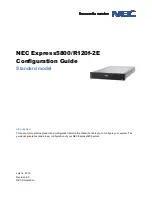
Chapter 11. Performance considerations
235
13,600 I/Os per second with the conservative numbers. These numbers vary depending on
the server type used.
The ESS 800 has an aggregated bandwidth of about 500 MB/sec for highly sequential reads
and about 350 MB/sec for sequential writes. The DS6800 can achieve higher data rates than
an ESS 800.
In a z/OS environment a typical transaction workload might perform on an ESS 800 Turbo II
with a large cache configuration slightly better than with a DS6800. This is the only example
where the ESS 800 outperforms the DS6800. In all open systems environments, the DS6800
performs better than the ESS 800. This is also true for sequential throughput in z/OS
environments.
11.5.3 An appropriate DS6000 size in z/OS environments
The potential of the architecture, its implementation and utilized technology allow for some
projections at this point (though without having the hard figures at hand). Rules of thumb have
the potential to be proven wrong. Therefore you see here some recommendations on sizing
which are rather conservative.
A fully configured ESS 800 Turbo with CKD volumes only and 16 FICON channels is good for
the following:
Over 30,000 I/Os per second
More than 500 MB/sec aggregated sequential read throughput
About 350 MB/sec sequential write throughput in mirrored cache
Without discrete DS6000 benchmark figures, a sizing approach to follow could be to propose
how many ESS 800s might be consolidated into a DS6000 model. From that you can derive
the number of ESS 750s, ESS F20s, and ESS E20s which can collapse into a DS6000. The
older ESS models have a known relationship to the ESS 800.
Further considerations are, for example, the connection technology used, like FICON or
FICON Express channels, and the number of channels.
Generally speaking, a properly configured DS6000 has the potential to provide the same or
better numbers than an ESS 800, except for transaction workloads with a large cache in the
ESS. Since the ESS 800 has the performance capabilities of two ESS F20s, a properly
configured DS6000 can replace two ESS F20s.
Processor memory size considerations for z/OS environments
Processor memory or cache in the DS6000 contributes to very high I/O rates and helps to
minimize I/O response time.
It is not just the pure cache size which accounts for good performance figures. Economical
use of cache and smart, adaptive caching algorithms are just as important to guarantee
outstanding performance. This is implemented in the DS6000 series, except for the cache
segment size, which is currently 68 KB.
Processor memory is subdivided into a data in cache portion, which holds data in volatile
memory, and a persistent part of the memory, which functions as NVS to hold DASD fast
write (DFW) data until staged to disk.
The IBM Tucson performance evaluation lab suggests a certain ratio between cache size to
backstore capacity. In general, the recommendation is:
0.5% cache to backstore ratio for z/OS high performance
Summary of Contents for System storage DS6000 Series
Page 2: ......
Page 5: ...iii...
Page 6: ...iv DS6000 Series Concepts and Architecture...
Page 18: ...xvi DS6000 Series Concepts and Architecture...
Page 24: ...xxii DS6000 Series Concepts and Architecture...
Page 26: ...2 DS6000 Series Concepts and Architecture...
Page 44: ...20 DS6000 Series Concepts and Architecture...
Page 46: ...22 DS6000 Series Concepts and Architecture...
Page 68: ...44 DS6000 Series Concepts and Architecture...
Page 88: ...64 DS6000 Series Concepts and Architecture...
Page 136: ...112 DS6000 Series Concepts and Architecture...
Page 138: ...114 DS6000 Series Concepts and Architecture...
Page 218: ...194 DS6000 Series Concepts and Architecture...
Page 242: ...218 DS6000 Series Concepts and Architecture...
Page 266: ...242 DS6000 Series Concepts and Architecture...
Page 298: ...274 DS6000 Series Concepts and Architecture...
Page 352: ...328 DS6000 Series Concepts and Architecture...
Page 392: ...368 DS6000 Series Concepts and Architecture...
Page 396: ...372 DS6000 Series Concepts and Architecture...
Page 404: ...DS6000 Series Concepts and Architecture DS6000 Series Concepts and Architecture...
Page 405: ......
















































